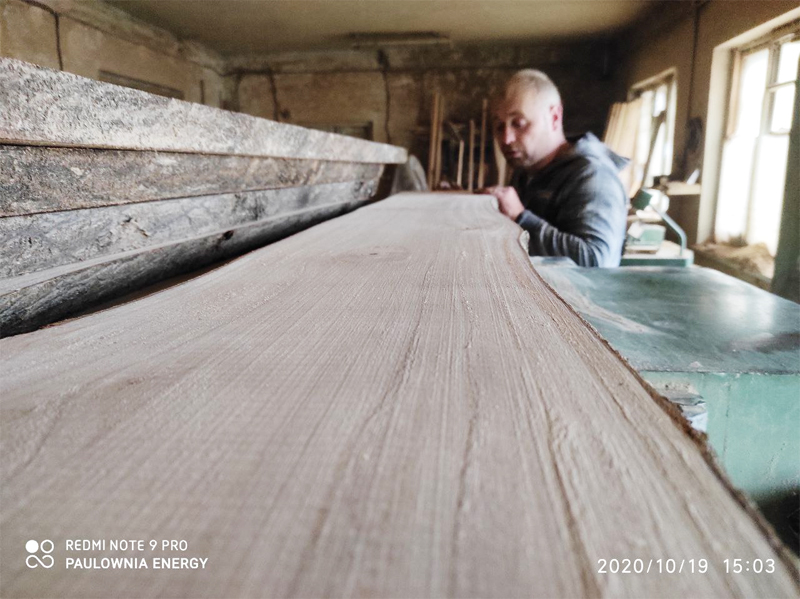Properties and characteristics of Paulownia wood

Paulownia wood is known for its unique properties and characteristics, which make it suitable for a wide range of uses. Some of the key properties and characteristics of Paulownia wood include:
-
Lightweight: Paulownia wood is significantly lighter than other types of hardwood, making it easy to handle and transport.
-
Strong and durable: Despite its lightweight, Paulownia wood is also strong and durable, making it suitable for use in furniture, construction, and other applications that require a strong material.
-
High insulation properties: Paulownia wood is known for its good insulation properties, which makes it suitable for use in construction and other applications where insulation is important.
-
Low shrinkage: Paulownia wood has low shrinkage and swelling, which makes it stable and less likely to warp or twist.
-
Good decay resistance: Paulownia wood is resistant to decay, rot and insects, which makes it a suitable material for use in outdoor applications.
-
Fine and even texture: Paulownia wood has a fine and even texture, which makes it suitable for use in decorative applications such as furniture and musical instruments.
-
Easy to work with: Paulownia wood is easy to work with, it can be sawed, planed, nailed, and glued with ease.
-
Good color and grain pattern: Paulownia wood has a beautiful color and grain pattern, which makes it suitable for use in decorative applications.
-
High thermal insulation: Paulownia wood has very good thermal insulation properties, which makes it suitable for use in construction, as well as for other applications where thermal insulation is important.
In summary, Paulownia wood is a versatile and unique wood species, it has a combination of properties such as lightweight, strength, durability.
Paulownia wood has some additional interesting properties and characteristics that set it apart from other types of wood:
-
Fast-growing: One of the most interesting characteristics of Paulownia wood is that the tree it comes from is a fast-growing species, which means that it can be harvested for wood production in a relatively short period of time, as compare to other woods.
-
High thermal conductivity: Paulownia wood has a high thermal conductivity, which makes it an efficient material for use in energy-efficient construction.
-
Sound-deadening properties: Paulownia wood is known to have sound-deadening properties, which makes it suitable for use in applications where sound insulation is important, such as in soundproofing music studios and recording rooms.
-
Hypoallergenic properties: Paulownia wood is known to have hypoallergenic properties, making it suitable for people who are sensitive to certain types of wood.
-
Absorbs and releases moisture: Paulownia wood has the ability to absorb and release moisture, which can help to maintain a stable and comfortable indoor environment, this makes it suitable for use in furniture and flooring.
-
Biodegradable: Paulownia wood is biodegradable, it can be broken down by natural processes, which makes it an environmentally friendly option.
-
Low density: Paulownia wood has a low density which makes it easy to work with and transport, it is also lightweight which makes it easy to handle.
-
Non-toxic: Paulownia wood is non-toxic, making it safe to use in applications where contact with food is possible, such as kitchenware or cutting boards.
In summary, Paulownia wood has a unique combination of properties and characteristics that make it suitable for a wide range of uses. It's fast-growing nature, high thermal conductivity, sound-deadening properties, hypoallergenic properties, moisture-regulating properties, biodegradable, low density, and non-toxic properties make it a valuable resource for many industries.
Paulownia wood has a number of interesting properties and characteristics that make it a valuable resource for various industries.
-
High dimensional stability: Paulownia wood has a high dimensional stability, meaning it doesn't expand or contract much with changes in humidity and temperature. This makes it an ideal material for use in applications where dimensional stability is important, such as furniture, flooring and musical instruments.
-
Low density: Paulownia wood has a low density compared to other types of hardwood, making it lightweight and easy to handle. This makes it an ideal material for use in applications where weight is a concern, such as in boats, aircraft, and automotive parts.
-
Good acoustic properties: Paulownia wood has good acoustic properties, making it suitable for use in soundproofing and musical instruments. This is due to its low density and high dimensional stability, which allows sound waves to travel through the wood with minimal damping.
-
Highly resistant to decay: Paulownia wood is highly resistant to decay, rot and insects, which makes it an ideal material for use in outdoor applications such as decking, fencing, and other landscaping projects.
-
High thermal insulation: Paulownia wood has very good thermal insulation properties, which makes it suitable for use in construction, as well as for other applications where thermal insulation is important.
-
Easy to machine: Paulownia wood is easy to machine, it can be sawed, planed, nailed, and glued with ease, making it an easy wood to work with.
-
Natural UV resistance: Paulownia wood has a natural UV resistance, which means that it doesn't change color or degrade when exposed to sunlight, making it suitable for outdoor use.
-
High carbon sequestration rate: Paulownia wood has a high carbon sequestration rate, making it an ideal tree for carbon sequestration and reforestation.
Overall, Paulownia wood is a valuable resource due to its unique properties and characteristics. It can be used in a wide range of industries, from construction to musical instruments and from furniture to environmental protection.



